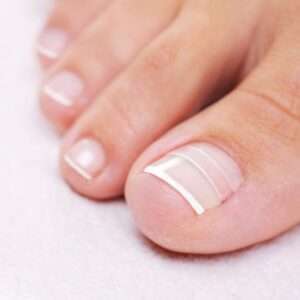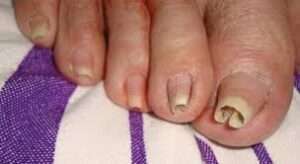Here you find out how to fix a pincer nail at home. Learn greater about this condition and why you might be at risk for ingrown toenails if you have it.
How to fix a pincer nail at home?
The majority are familiar with ingrown toenails. Despite the fact that they’ve by no means suffered from one, which is rare in and of itself, they’ve in all likelihood known a person that has. It’s a fairly common problem. But, there’s a type of ingrown nail which could cause more pain and is more difficult to treat than the regular kind of Pincer toenails.

You may like: What does avocado taste like?
If you note that your toenails have a curled look or that the lateral edges appear to slope inward towards each other as the unfastened aspect grows, you could have what’s called a pincer nail.
Right here’s the way to reduce curved toenails.
Home treatments:
- Soak the feet in warm water, blended with a few spoons of salt, for approximately 20 minutes three times in keeping with the day.
- Use a cotton ball to push way the adjoining pores and skin from the edges of the toenail. Soak the cotton in olive oil before utilization.
- practice antibiotic ointments across the inflamed location to avoid the development of contamination.
- Use over-the-counter medicines for the ache
Using Curve correct
Curve correct is one of the most popular treatment options for curved toenails. performing as a spring, it gently pulls the edges of the nail up inflicting it to develop without pressing into the encompassing pores and skin. Curve accurate can accurately curved toenails in weeks relying upon the diploma. Curve correct completely treatments curved toenail hassle and maybe very secure to apply. You may observe Curve correctly at home within 5 mins. check out the contemporary price of Curve correct online.
Application of Curve accurate
- Prepare your nail: this involves trimming and cleaning. Trim the nail and wash it thoroughly. Use soap and water to wash all contaminants off.
- A pre-fit brace to determine the angle of application
- Report toenail to ensure the surface is smooth enough.
- Smooth the nail floor with a solvent
- Observe adhesive to at least one end of the brace and location it on the end of the toenail used for pre-healthy. do that quickly earlier than the adhesive treatment plans.
- Test to make sure the brace is in the identical period as the toenail. Trim if essential.
- Then add adhesive to the opposite end of the brace and finally located it at the toenail, maintaining it down for best curing.
What causes Pincer Toenails?
Pincer toenails are nail deformity that causes over-curvature inside the nail. There may be several reasons for pincer toenails, together with:
- A fungal disease, like Onychomycosis
- positive medicinal drugs, like beta-blockers
- A tumor or cyst near the nail bed
- Autoimmune sicknesses, like lupus or psoriasis
- An own family history of pincer nails (even though no particular genes were identified)
You’ll want to go to a podiatrist to find the basis motive of your pincer toenails. If it’s far resulting from something like onychomycosis, then the podiatrist can prescribe an antifungal remedy.
What Do You Do If Pincer Nails do not leave?
When you have an autoimmune ailment or a family history of pincer nails, it could be more difficult to put off this circumstance. Pincer nails are not inherently terrible, and in the event that they keep taking place, then the intention may just be to manage the condition.

You may like: What do cats like to eat for breakfast?
As an instance, you can lessen the improvement of pincer nails by using fending off tight socks and tight shoes, like high heels. If your pincer nails are caused by positive medicines, you can need to speak along with your doctor approximately alternative alternatives with fewer aspect outcomes.
The principal issue of routine pincer nails is the improvement of ingrown toenails. So if you have pincer nails, then you definitely have to maintain an eye out for ingrown toenails.
What are Ingrown Toenails?
While the rims of your nails pierce the encompassing skin and maintain development, this is called an ingrown toenail. this is a very not unusual circumstance in massive toenails. when you have an ingrown toenail, you can have a
- A foot smell
- Drainage or pus around the toe
- Ache, redness, or swelling
- Extra pores and skin tissue across the injured area
Because pincer toenails curl and taper inward, it is even less difficult for toenails to grow into the pores and skin. Ingrown toenails can start off as a moderate infection, but they can end up in greater pain due to the fact trapped bacteria and particles can reason infections. If you have diabetes or circulation issues, then ingrown toenails can grow to be risky infections.
How can you keep away from ingrown toenails with pincer nails?
When you have pincer nails, you will be tempted to trim the free give up very short. but, this can boom the risk of ingrown toenails, so it’s an excellent concept to let the loose stop growing out a little bit. Your podiatrist can then fit you with a special orthotic to slowly straighten your nail plates. As soon as the nail plate is straightened, it is going to be less in all likelihood to become an ingrown toenail.

When you do need to trim your toenails, don’t clip them at a pointy proper angle. Trimming your nails this way will make it simpler for the nail to pierce and grow into the skin.
If you play sports or exercise a lot, deliver an extra pair of socks so you don’t work out in damp socks. moist environments can be a breeding floor for fungus and microorganisms, like Staphylococcus, that can motive infections in ingrown toenails.
Finally, when you have intense, routine pincer nails, your podiatrist may additionally opt for a surgical procedure to absolutely eliminate the nail matrix or root. During these surgical procedures, the podiatrist will use a nearby anesthetic to numb your foot. Then they will use a chemical or a laser to take away the toenail.
Read more:

